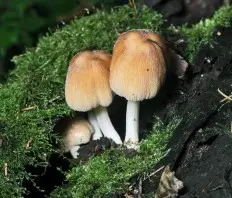Willow dung beetle (Coprinellus truncorum)
- Division: Basidiomycota (Basidiomycetes)
- Subdivision: Agaricomycotina (Agaricomycetes)
- Class: Agaricomycetes (Agaricomycetes)
- Subclass: Agaricomycetidae (Agaricomycetes)
- Order: Agaricales (Agaric or Lamellar)
- Family: Psathyrellaceae (Psatyrellaceae)
- Genus: Coprinellus
- Type: Coprinellus truncorum (willow dung beetle)
- Agaric logs Scop.
- A pile of logs (Scop.)
- Coprinus micaceus sensu Lange
- Watery agaric Huds.
- Agaricus succinius Batsch
- Coprinus trunks var. eccentric
- Coprinus baliocephalus Bogart
- Granulated leather Bogart

Current name: Coprinellus truncorum (Scop.) Redhead, Vilgalys & Moncalvo, Taxon 50 (1): 235 (2001)
The situation with this dung beetle was not easy.
DNA studies cited by Kuo (Michael Kuo) in 2001 and 2004 showed that Coprinellus micaceus and Coprinellus truncorum (willow dung beetle) may be genetically identical. Thus, for the North American continent, Coprinellus truncorum = Coprinellus micaceus, and the description for them is “one for two”. This is rather strange, because the same Kuo gives different spore sizes for these two species.
Whatever the case in America, Index Fungorum and MycoBank are not synonymous with these species.
Coprinellus truncorum was first described in 1772 by Giovanni Antonio Scopoli as Agaricus truncorum Bull. In 1838 Elias Fries transferred it to the genus Coprinus and in 2001 it was transferred to the genus Coprinellus.
head: 1-5 cm, up to a maximum of 7 cm when open. Thin, at first elliptical, ovoid, then bell-shaped, in old or drying mushrooms – almost prostrate. The surface of the cap is radially fibrous, with irregularities and wrinkles. The skin is white-brownish, yellow-brown, slightly darker in the center, covered with a white, not shiny, fine-grained coating. With age, it becomes naked, since the plaque (remains of a common coverlet) is washed off by rain and dew, sprinkled. The flesh in the cap is thin, plates appear through it, so that even very young specimens have a cap all in “wrinkles” and folds, they are more pronounced than the scars of the shimmering dung beetle.
plates: free, frequent, with plates, number of full plates 55-60, width 3-8 mm. White, whitish in young specimens, gray-brown with age, then blacken and quickly dissolve.
Leg: height 4–10, even up to 12 cm, thickness 2–7 mm. Cylindrical, hollow inside, thickened at the base, may be with an unexpressed annular thickening. The surface is silky to the touch, smooth or covered with very thin fibers, whitish in young mushrooms.
Ozonium: missing. What is “Ozonium” and how it looks – in the article Homemade dung beetle.
Pulp: white, whitish, brittle, fibrous in the stem.
Spore powder imprint: the black.
Споры 6,7-9,3 x 4,7-6,4 (7) x 4,2-5,6 µm, ellipsoid or ovate, with rounded base and apex, reddish brown. The central pore of the germ cell is 1.0–1.3 µm wide.
Willow dung beetle is obviously a conditionally edible mushroom, just like its twin brother, Shimmering dung beetle.
Only young hats should be collected, preliminary boiling is recommended, at least 5 minutes.
It grows from late spring to autumn, in forests, parks, squares, pastures and cemeteries, on rotting trees, stumps and near them, especially on poplars and willows, but does not disdain other deciduous trees. Can grow in rich organic soil.
Rare view. Or, more likely, most amateur mushroom pickers mistake it for Glimmer Dung.
Mainly found in Europe and North America. Outside these continents, only the southern fringes of Argentina and southwestern Australia have been recorded.
In the scientific literature of Poland, many confirmed finds are described.

Flickering dung beetle (Coprinellus micaceus)
According to some authors, Coprinellus truncorum and Coprinellus micaceus are so similar that they are not separate species, but synonyms. According to the descriptions, they differ only in minor structural details of the cystids. Preliminary results of genetic tests showed no genetic differences between these species. An unreliable macro-sign: in the shimmering dung beetle, the particles on the hat look like shiny fragments of mother-of-pearl or pearls, while in the willow dung bee they are simply white, without shine. And the willow dung beetle has a slightly more “folded” hat than the shimmering one.
For a complete list of similar species, see the article Flickering dung beetle.









